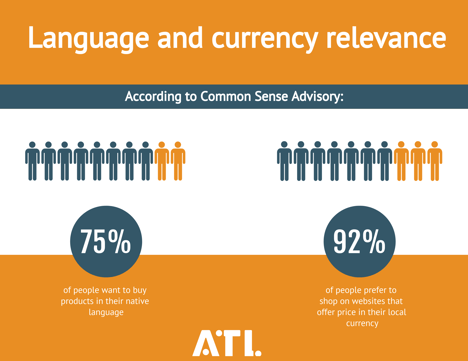 In one of the Brave by Design episodes, Laura Khalil explains how tough it is for a marketer to be understood by start-up owners with an engineering background.
In one of the Brave by Design episodes, Laura Khalil explains how tough it is for a marketer to be understood by start-up owners with an engineering background.
The general idea is that marketing is supposed to be an easy job that anybody can do.
If you are a marketing person, you are probably rolling your eyes right now, and you completely understand what she meant. If you are not a marketing person, you might have heard marketing people trying to explain what makes their everyday tasks complex.
Marketing isn't a piece of cake, and the same rules apply when we talk about marketing translation.
Being exposed to a multitude of marketing content every day as regular consumers, we at ATL have seen a lot of bad multilingual marketing campaigns.
We have seen marketing campaigns that contained linguistic errors, were culturally inappropriate, or were ineffective. We know where these problems come from, and this article will discuss 10 ways to make your multilingual marketing content fail you.
One of the reasons for ineffective multilingual marketing campaign is assigning localization to marketing teams.
Success in the new market depends largely on communication with the local buyers. It doesn't matter if your new potential buyers speak English or not. One out of ten people is said to refrain from buying a product if it's not localized.

Localization means adopting the product to a particular market. But is your marketing team the best choice when it comes to translation? Not really.
They are paid to carry out their marketing-related tasks. The time spent on translation means them not focusing on their primary duties, or developing new marketing skills.
Also, people who do not translate for a living don't do it as fast as experienced localization professionals. Are they the best person to know exactly what your product's features are? Or, are they more of an expert in brand positioning, driving qualified traffic or organic and paid acquisition channels?
Related content: Translation Agency vs. In-house Marketing Team: Who Should Translate Your Content?
The translation process may turn into a long and drawn out process, and the multilingual marketing content may be late for your product launch.
In this scenario, marketing teams are often rushing between their regular duties and translation. Consequently, assigning translation to the marketing teams can lead to time-consuming, poor-quality translations, as well as underperforming marketing campaigns.
It is very peculiar that some decision-makers want their companies to increase global expansion and they understand the need of having a multilingual website, yet they do not secure an adequate translation budget.
Unfortunately, the budget allocated for localization is often small, and companies have to squeeze the globalization requirements within a very limited amount of money. May it be 10% of the marketing budget or less, it can be done. The key here is to use translation budget wisely.
Related content: 7 Tips to Avoid Wasting Your Translation Budget
Beware of companies that provide the cheapest quote. Sometimes the offers lack important services that need to be paid separately like SEO (Search Engine Optimization) localization.
SEO localization is a service that can boost your multilingual marketing content, or slow it down. Working with international keywords that will help your clients find you on Internet requires a specific know-how and experience, but it also requires time for research.
Some characteristic features of your product may not resonate with the local audience and therefore these keywords need to be replaced with appropriate local terms that will bring traffic to your website.
Let's take blinds as an example. A company's English keyword tubular motor translated into Spanish as motor tubular is less performant than motores para persianas (motors for blinds).
In this case it's worth considering not only keyword optimization but also research, and these are all additional services that may not be included in the lowest localization quote.
The lowest rate often results in poor quality translation resources. This may also lead to poor translation quality. In the worst cases, your multilingual marketing content may contain grammar, spelling errors, or mistranslations.
Last but not least, low rates can mean lack of transcreation service. Transcreation is the highest level of marketing translation.
It's the form of translation closest to copywriting, and naturally the most expensive. Whenever you are launching a new product, you need a professionally localized marketing campaign.
Related content: 10 Signs That Indicate Bad Marketing Translation Services
.png?width=472&name=countries%20and%20locale%20for%20translation%20(1).png)
One of the first questions you should ask yourself while planning marketing content localization is: Who is my local audience? What languages do these people speak?
Let's take Switzerland as an example. It's a beautiful European country famous mostly for the Alps, Lindt Chocolate, Rolex, Cartier and Helvetica. It is among the top 5 wealthiest countries in Europe, and has four official languages. Yes, four languages: German, French, Italian, and Romansh.
Switzerland is not the only example of a country with a variety of official languages. Canada also uses more than one language, namely English and French.
Related content: 15 Languages for Translation That You Should Know About
Failing to provide multilingual content for a country using more than one official language can really damage your marketing plans. On the other hand, using this knowledge for the appropriate adaptation of your marketing material can give you a competitive advantage.
Graphics used in your marketing content provide context and support your message to the reader. Make sure that the message is appropriate and can be easily understood by readers living in different countries.
Graphics can use symbols that are familiar to people living in one culture, that may not be understood by people living in another.
There are plenty of examples, but as the mother of a newborn baby, the story of Procter and Gamble's disposable diapers marketing campaign in Japan is my favorite.
Product sales didn't reach the predicted numbers, given that the packaging of "Pampers" used a stork as a symbol associated with a new baby. This symbol is widely understood in most of the Western world, but is not relevant in Asia.
In Japan, the legend is that babies come from peaches floating down the river, or from a bamboo stick. So, without a closer examination of the packaging, parents didn't understand the purpose of the product at first glance, and why it was placed in an aisle intended for baby products.

Although the context is cute as a newborn baby, the actual problem was a serious one for the Procter and Gamble team.
There are numerous differences among cultures, and it is very important to remember that not only the words need localization but visuals do, too.
Numbers play a very important role in many cultures. Friday the 13th is said to be an unlucky day for most of the Western cultures. But there are places where the number 13 is associated with luck.
A marketing campaign offering 4% discount in China, which should make your clients happy, may have the opposite effect. The reason is that the number 4 is perceived as unlucky in China. Making it 3.89% should work much better because of their lucky numbers, 8 and 9.
Except for the additional meaning of numbers, you shouldn't forget about the basics, either.
Remember to convert prices into the buyer's currency. For example, it will be Euros for most European countries, Pound sterling for Great Britain and Japanese yen for Japan.
.png?width=517&name=localize%20measuring%20system%20(1).png)
There will be content that describes your product in relation to size for example. And in this case, size matters a lot!
Imagine you are selling a laptop. The screen size can be provided in inches, but what about the device's size and weight? Almost there.
Think about buyers who use metric system. Include size in centimeters and weight in kilograms for them. And this is not just a favor to the user, it is a legal requirement.
Also, remember time and date formats in your marketing campaigns, because the date 02-08-2021 in France means August 2nd, not February, 8th.
Whatever you sell, make sure that you communicate in a culturally appropriate way with your international audience. Going global means adopting your content or products to cultural and social requirements.
For example, a beer can be sold in so many different countries. The MLDA (Minimum Legal Drinking Age) is a factor that needs to be taken into account. The MLDA varies worldwide. It is 21 years old in the USA, 18 in Australia and 16 in Italy. There are also countries like Qatar where drinking alcohol is prohibited.
This needs to be taken into account while preparing a marketing campaign. Not only will the text itself contain different information for various countries, but the graphics and videos need to address a target audience of appropriate age.
Not all available fonts can be used locally. There are special characters used in some languages. These include letters with diacritic marks, in Spanish and German for example, or logograms used instead of letters in Chinese.
This is more of a technical aspect, but forgetting about it can successfully distract potential buyers from your printed marketing material.
Making sure that the chosen font supports local special characters brings you closer to material that reads well.
Many sophisticated fonts do not support local special characters. What happens is that the letters are most often missing their diacritical mark.
.png?width=499&name=local%20holidays%20in%20localization%20(1).png)
If you are thinking about having a special marketing campaign to celebrate the 4th of July, that's cool, as long as you know that in most of the countries it is just another day.
The same goes for other special occasions like Halloween, which isn't celebrated in every country all over the world. The same with Mother's Day. This special day is celebrated almost everywhere in the world, but at different dates. If you sell maternity-related products, it would be great to offer a Mother's Day special deal but make sure you do so on the day it is really celebrated in the buyer's country.
Make sure to be aware how your clients from various countries should be addressed.
An informal tone is almost taken for granted in English. Using Sir and Madam in your marketing communication might sound a little weird.
German, French and Japanese are quite the opposite. A familiar tone might come off as rude with those audiences.

Not only the formal or informal tone should be taken into consideration for multilingual marketing campaigns.
You need to include an automated mailing, but with personalized greetings. Think about highly inflected languages like Polish or Finnish. In this case, you can't use the template Dear (name) and automatically insert the name after having translated the word dear in your communication with local users.
If you do that, the personalized greeting will sound unnatural, and that is not the goal. Such a message can even finish directly in the spam folder.
Most people read in an F-shaped pattern. This means that the most important information should be placed on the top left side, since people from the West read from left to right.
When providing the Arabic version of your leaflet, bear in mind that the most important information should be placed on the right.
You can’t simply translate the content and place it from right to left. Design the layout of the graphics accordingly. Make sure that the reading preferences of your local audience are respected.
There are languages that are longer or shorter than English. In order to avoid shrinking the font to an illegible size, remember to keep available space in mind.
There are different page sizes used outside of the USA.
All of these aspects affect the development of printable elements for your multilingual marketing content.
No matter if you already have your multilingual marketing content ready, or if you are just considering translating it, remember to adapt it to local buyers. Otherwise, the cost of your multilingual marketing campaign won't be justified.
A serious marketing localization service provider combines mindset, toolset, and strategy to address what's needed for your global success.
Sometimes it requires the understanding of what's blocking your brand's global growth. It could be an incorrectly translated website, or marketing material that doesn't reach the local clients.
Make sure you find the right localization experts that support your global expansion and help you avoid all the mistakes in creating multilingual marketing content.
Recommended articles:
+1 857 777 5741 ext. 203 (business inquiries)
+1 857 777 5741 ext. 205 (career inquiries)
Trylinskiego 16, 10-683
Olsztyn, Poland
Copyright ATL 2025. All Rights Reserved.